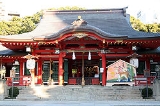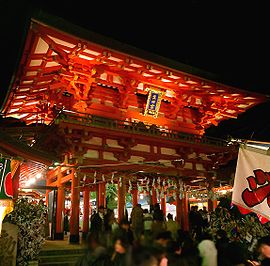
Ikuta Shrine
Encyclopedia
is a Shinto
shrine
in the Chūō Ward of Kobe
, Japan
, and is possibly among the oldest shrines in the country.
According to Nihon Shoki
, it was founded by the Empress Jingū at the beginning of the 3rd century AD to enshrine the kami
Wakahirume, and was used as the base for a festival welcoming warriors back from the latest attempt to invade Korea
. It was one of three shrines established at this time, the others being Hirota Shrine
, dedicated to Amaterasu
, and Nagata Shrine
, dedicated to Kotoshiro-nushi (also known as Ebisu
).
During the Genpei War
, parts of the Battle of Ichi-no-Tani
took place in and around this shrine, and are commemorated by markers in the Ikuta forest behind the shrine. Of course, the shrine's land was much larger back then, before the city of Kobe
was built around it. Thus, the precise locations of skirmishes or events can no longer be commemorated on shrine land.
 Today, two Noh
Today, two Noh
plays, Ebira
and Ikuta Atsumori
, which retell aspects of the Genpei War
, are performed near the Ikuta Shrine on a regular basis. They are performed every year at Ikuta's .
Shinto
or Shintoism, also kami-no-michi, is the indigenous spirituality of Japan and the Japanese people. It is a set of practices, to be carried out diligently, to establish a connection between present day Japan and its ancient past. Shinto practices were first recorded and codified in the written...
shrine
Jinja (Shinto)
A Shinto shrine is a structure whose main purpose is to house one or more Shinto kami....
in the Chūō Ward of Kobe
Kobe
, pronounced , is the fifth-largest city in Japan and is the capital city of Hyōgo Prefecture on the southern side of the main island of Honshū, approximately west of Osaka...
, Japan
Japan
Japan is an island nation in East Asia. Located in the Pacific Ocean, it lies to the east of the Sea of Japan, China, North Korea, South Korea and Russia, stretching from the Sea of Okhotsk in the north to the East China Sea and Taiwan in the south...
, and is possibly among the oldest shrines in the country.
According to Nihon Shoki
Nihon Shoki
The , sometimes translated as The Chronicles of Japan, is the second oldest book of classical Japanese history. It is more elaborate and detailed than the Kojiki, the oldest, and has proven to be an important tool for historians and archaeologists as it includes the most complete extant historical...
, it was founded by the Empress Jingū at the beginning of the 3rd century AD to enshrine the kami
Kami
is the Japanese word for the spirits, natural forces, or essence in the Shinto faith. Although the word is sometimes translated as "god" or "deity", some Shinto scholars argue that such a translation can cause a misunderstanding of the term...
Wakahirume, and was used as the base for a festival welcoming warriors back from the latest attempt to invade Korea
Korea
Korea ) is an East Asian geographic region that is currently divided into two separate sovereign states — North Korea and South Korea. Located on the Korean Peninsula, Korea is bordered by the People's Republic of China to the northwest, Russia to the northeast, and is separated from Japan to the...
. It was one of three shrines established at this time, the others being Hirota Shrine
Hirota Shrine
' is a Shinto shrine in Nishinomiya City, Hyōgo Prefecture, Japan. Nishinomiya literally means "shrine of the west," and the town is in fact named after Hirota Shrine.-Location:...
, dedicated to Amaterasu
Amaterasu
, or is apart of the Japanese myth cycle and also a major deity of the Shinto religion. She is the goddess of the sun, but also of the universe. the name Amaterasu derived from Amateru meaning "shining in heaven." The meaning of her whole name, Amaterasu-ōmikami, is "the great August kami who...
, and Nagata Shrine
Nagata Shrine
is a Shinto shrine in Nagata Ward, Kobe, Japan. At Nagata, Kotoshironushi-no-Okami is enshrined.The shrine is associated with Amaterasu, who is said to have told Empress Jingū that a shrine was wanted at Nagata.-History:...
, dedicated to Kotoshiro-nushi (also known as Ebisu
Ebisu (mythology)
Ebisu , also transliterated Yebisu or called Hiruko or Kotoshiro-nushi-no-kami , is the Japanese god of fishermen, luck, and workingmen, as well as the guardian of the health of small children...
).
During the Genpei War
Genpei War
The was a conflict between the Taira and Minamoto clans during the late-Heian period of Japan. It resulted in the fall of the Taira clan and the establishment of the Kamakura shogunate under Minamoto Yoritomo in 1192....
, parts of the Battle of Ichi-no-Tani
Battle of Ichi-no-Tani
' was a Taira fortress at Suma, to the west of present-day Kobe. It sat on a very narrow strip of shore, between mountains on the north, and the sea to the south. This made it quite defensible, but also made it difficult to maneuver troops inside the fortress. Minamoto no Yoshitsune split his force...
took place in and around this shrine, and are commemorated by markers in the Ikuta forest behind the shrine. Of course, the shrine's land was much larger back then, before the city of Kobe
Kobe
, pronounced , is the fifth-largest city in Japan and is the capital city of Hyōgo Prefecture on the southern side of the main island of Honshū, approximately west of Osaka...
was built around it. Thus, the precise locations of skirmishes or events can no longer be commemorated on shrine land.

Noh
, or - derived from the Sino-Japanese word for "skill" or "talent" - is a major form of classical Japanese musical drama that has been performed since the 14th century. Many characters are masked, with men playing male and female roles. Traditionally, a Noh "performance day" lasts all day and...
plays, Ebira
Ebira
The Ebira These days Ebira is no more pronounced or spelt "Igbira or Igbirra" because it is considered to be insultive to most of the Ebiras but then, Ebira people are an ethno-linguistic group of Nigeria. Many Ebira people are from Kogi State, Kwara State, Nasarawa State, Federal Capital...
and Ikuta Atsumori
Ikuta Atsumori
Ikuta Atsumori , sometimes known simply as Ikuta, is one of many Noh plays derived from the story of Taira no Atsumori, a young Taira clan samurai who was killed in the 1184 battle of Ichi-no-Tani...
, which retell aspects of the Genpei War
Genpei War
The was a conflict between the Taira and Minamoto clans during the late-Heian period of Japan. It resulted in the fall of the Taira clan and the establishment of the Kamakura shogunate under Minamoto Yoritomo in 1192....
, are performed near the Ikuta Shrine on a regular basis. They are performed every year at Ikuta's .
See also
- List of Shinto shrines
- Twenty-Two Shrines
- Modern system of ranked Shinto ShrinesModern system of ranked Shinto ShrinesThe The The (sometimes called simply , was an organizational aspect of the establishment of Japanese State Shinto. This system classified Shinto shrines as either official government shrines or "other" shrines...

